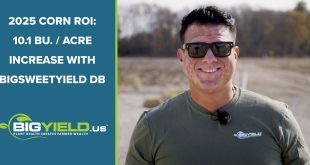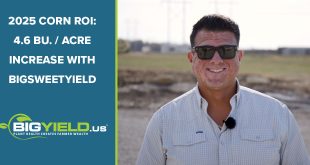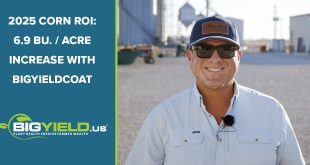In this “High Yields 101” video, BigYield agronomist Shane Hall covers his advice for managing weeds and pest problems. Keeping your fields clean and pest free is highly important for a profitable crop, so be sure to hear what Shane has to say. If you have any questions, contact us anytime.
Video Transcript
Hello all, it’s Shane Hall here again, I’m the CCA agronomist for BigYield, and again it’s a privilege to be able to come to you today and to share with you some of the thighs that we’re doing here on the farm and some of the things that we can do that you can do on your farm as part of your management to help boost those yields and specifically for today I want to talk to you a little bit about weed management and pest management as far as that goes.
When we’re thinking about our herbicide programs, one of the things we often forget is what I would call the butter and the bacon to our recipes, so what I mean by that so much of the time we concentrate on that post application and we don’t think about our pre-emerging application, and I know a lot of you guys are ahead of me on this, but those pre-emerging applications are butter and the bacon to our herbicide programs, we have to make sure we got those right. I know for many of you I see it a lot of folks in their programs they’re using that Metoolachor as a pre-emergent herbicide, that’s fine there’s nothing wrong with that, bit I would actually like to see that Group 15’s and Metoolachoras and those types of things used in a post application. I think they can be very useful and can provide residual in our post programs. So what do we use as pre’s, do we use one real good mode of action, that would be nice but I’d like to see us use at least two and maybe even three mode of action in our pre-emergent herbicide programs and we can start with Metribuzin and I think that that’s going to have really good control on some broadleaf weeds and some grasses, but also throw in a PPO into that, throw in authority or valor and I know some of you are already using that, but just in that we have two modes of action, we have a PPO herbicide and we have Metribuzin and that’s something that’s going to be very effective in our fields.
When it comes time to make those post-emergent applications, I know you’re having trouble because I’ve had trouble with it myself and others are having trouble so we have that, we have a post-emergent plan and then all of a sudden a rain comes and you can’t get in, those are things you can’t plan for, we can say I don’t need all that pre-emergent. I’m gonna save money of the pre-emergent then I’ll just nail it with that liberty, my fields or my weeds are responding really well to the liberty herbicides or my weeds are really responding well to the new chemistries that are coming out, well that may be true, but you can’t guarantee that you’re going to get into your field on time and you can’t guarantee that the weeds that are there are going to respond the way they should. So again this is my preaching for the day is to make sure that we’ve got a good pre-emergent herbicide program.
Another thing that goes along with that, and I’ll touch on this in another video, is making sure that our soils are correct because we think, okay well what does my soil quality have to do with my herbicide effectiveness or my herbicide efficacy. Well if you think about it, all of those herbicides require a specific pH in order to be at the top of their game.= and I’m sure that you don’t want to throw good money after bad when the pH in your soil just isn’t right, and in order to make those herbicides as effective as they can possibly be, what is your pH, what is your cation exchange capacity, what’s your organic matter look like. All those things are going to be important when thinking about your herbicide program, when thinking about tillage in your herbicide program, when are you doing it. So all those things are important, all of those things matter when it comes to making sure that we’ve got clean fields throughout the season. Weeds can rob us of our yield, we know that and so if you’ve had trouble with that make sure you’ve got a good strong weed control program going into 2021.
Now some of you may know I’m not a big proponent of preventive spraying when it comes to insects. I think that can maybe at items that can work, but I think you have to be able to tell the future in order for it to do any good, and there’ll be one exception to that that I’ll mention in just a moment, but preventative sprays at the very least that’s going to harm our beneficial insect population and we don’t want to do that because our lady bugs for example are going to do a number on the aphids that maybe are robbing us of yields that’s just one example. So you have to make sure that again we’ve got a proactive but non necessarily that we’re spraying preventatively. Now I said there would be an exception to that preventative spray, but it’s really not an exception because we’re looking for insects before we spray. We want to make sure that we’ve got an issue before we go about A: spending money on an insecticide, and be exposing our field and exposing the area and our beneficial to those herbicides or those insecticides. So one exception would be is this year I’m going to do a lot more of it and I’ve done it in the past is set out pheromone traps in order to catch moths, and what that’s going to do is that’s going to tell me what type of populations we’re going to have with the larva and with the worms such as corn borer and such as the earworm. We can also do that with army worms and fall army worms and all those types pf things to give us an idea what type of populations we’re going to have in the future, catch the moths and try to find out what type of feeding is going to occur on our plants, so in doing that when we know we can spray and we can be preventative in that way.
So again there is a good way to be proactive in that arena as well, so as far as we weed management and pest management are concerned the important thing is to make a plan, have a plan and know what we’re going into and that plan could be different for every field. You could have a field that you just don’t have a lot of problems with resistant weeds, and if that’s the case maybe you’re able to go with just one pre-emergent herbicide because you know you have a good post program coming up, but if that’s not the case then for every field and you’ve got a field that’s always been a problem then we have to be a little more proactive, you may have to spend a few more dollars on the front end so that you’re saving yield and so you’re making more money on the back end. You may have to go with a couple of pre-emergent herbicides, if you’ve got a field and you know you’re going with conventional corn and you know that you’ve had with worms in that corn before, and they’ve cost you yield, the you’ve got to be proactive and make a plan and know that that may be coming.
I hope this has been a helpful video to you, and if you have any questions feel free to give me a call, again my name’s Shane and I look forward to talking to you soon.
 BigYield High Yield Soybeans, High Yield Corn, and High Yield Wheat
BigYield High Yield Soybeans, High Yield Corn, and High Yield Wheat



